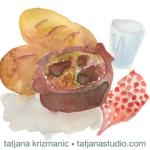Award Winning Author
Face Reading with Before & After Photos
Warming Foods
It’s fascinating and informing how some foods warm you up and others cool you down. In a heat-wave, it’s watermelon you want and not a hearty lamb stew. Here’s how to adjust your food choices and cooking styles to assure your thermal ease.
This isn’t new information. In early Persian, Indian and Chinese literature, foods were ranked according to their ability to influence body temperature. Fortunately, this wisdom is resurfacing.
Let’s examine its basic, common sense principles as applied to (1) a food’s inherent thermal properties and (2) how a food is prepared. Then, no matter how the outdoor temperatures may soar or plummet, you can be more comfortable.
According to traditional culinary wisdom, foods are hot, warm, neutral, cool or cold. Spices tend to be warming and fruit tends to be cooling. Garlic, for example, fires you up while peaches cool you down.
To assess a food’s thermal properties, you don’t have to memorize endless food lists. Rather, follow the following guidelines to enhance your comfort and well-being.
- Growth time — Foods that grow quickly, like bean sprouts, cucumbers and summer squash, tend to be more cooling than foods that take longer to grow, like cabbage, carrots and winter squash.
- Color — Blue, green, or purple colored foods are typically more cooling than similar foods that are red, orange or yellow. Thus, a lime cools more than a lemon. Blue fish is more cooling than salmon.
- Region — Tropical and sub-tropical foods tend to be more cooling than temperate-zone foods. Strawberries and cherries are more warming than mangos and pineapple.
- Water content — Juicy foods tend to be more cooling than dry foods. Therefore, Chinese cabbage is more cooling than cabbage and milk, more cooling than cheese.
If you’re eating from your garden or buying from our local Growers’ Markets, you will automatically be more in balance with the season. Summer cucumbers, green beans and lettuces are more cooling than are fall squash, cabbages and turnips.
Secondly, consider how food preparation affects a food’s thermal properties. Raw foods are more cooling than are cooked foods. Additionally, a chilled, iced or frozen food is more cooling than the same food served warm or at room temperature. Cooking energizes by adding heat and partially breaking the food down, which aids digestion. So even though it’s hot outside, you’ll still eat predominately cooked, and therefore more digestible, foods. On a sweltering day, you’ll favor a chilled, versus steaming, bowl of borscht.
Consider a carrot. Carrot juice is more cooling than a grated carrot salad. A carrot salad is more cooling than carrot soup. If it were freezing outside (or if you tend to be cold even in the heat) then grilling or frying that carrot would make it more warming, and help you be more comfortable.
To enhance a food’s warmth, cook it with more time, more fat or oil, at higher temperatures, under greater pressure, with more heating spices and/or with less water. To make it more cooling, use less of the above except, perhaps, for water as generally on a hot day you’ll want your food to be more juicy and hydrating.
Experiment and pay attention to how foods make you feel. As you adjust your cooking techniques and food choices according to the season and to your thermal needs, you’ll support your health and well-being.
Recipes for cooling dishes include: Rainbow Salad, Garden Salad with Dulse and Walnuts, and Green Beans. More warming recipes are: Ginger Tea, Better than Fried Chicken and Stuffed Cabbage Rolls.
May you be well nourished,


